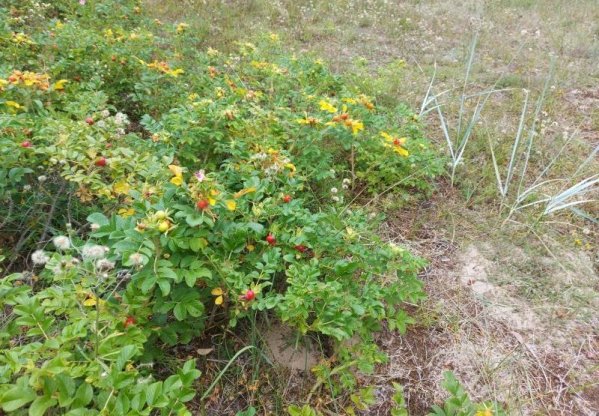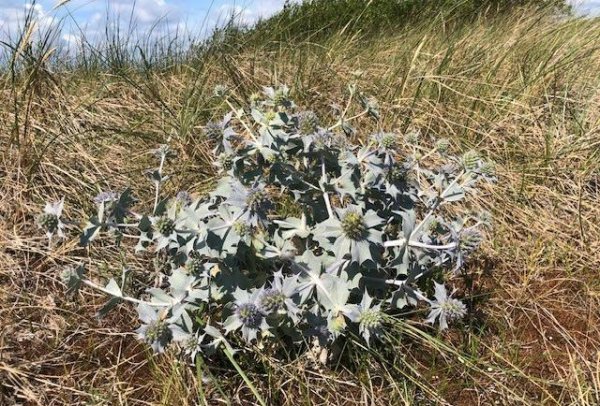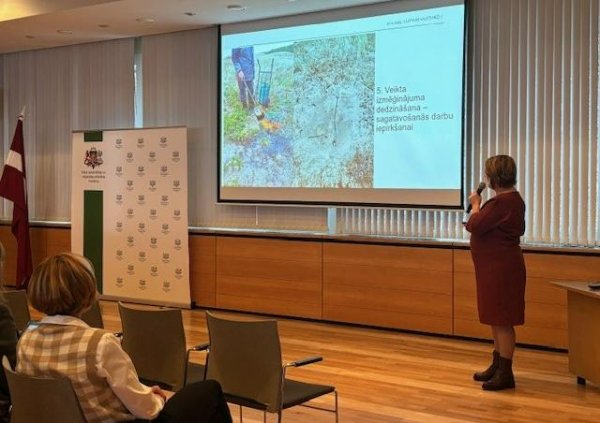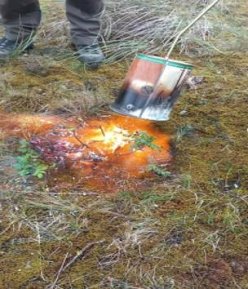Measures are Being Taken to Control the Spread of the Beach Rose in Ziemupe Nature Reserve
This year, JSC “Latvia's State Forests” (LVM) will start the work for limiting the spread of an invasive species – the beach rose (Rosa rugosa) – in Ziemupe Nature Reserve; the works will be performed in a total area of 10 hectares, using three environmentally friendly methods. The work aims to protect habitats of unique and rare species in Latvia and habitats of open seaside dunes, which are suppressed by the invasive rose, and at the same time to find the most effective method to limit the spread of this invasive plant.
Ziemupe Nature Reserve is one of the two places in Latvia where the sea holly (Eryngium maritimum), which is specially protected in Latvia as well as in the European Union, is registered. The beach rose, with its wide distribution, good vitality and deep root system, suppresses the stands of this rare and exotic species, therefore, limiting the rose will also improve the living conditions of the sea holly and restore its natural habitat – open seaside dunes.
In the photo: sea holly or Eryngium maritimum
At the end of 2023, a seminar on invasive species of Latvia was held in the premises of the Ministry of Environmental Protection and Regional Development, where the recently published “Handbook of Invasive Species” created by Latvian scientists and experts was also presented. Specialists in the field participated in the seminar with reports on the spread and limitation of various invasive species in Latvia. Dace Gūtmane, Head of LVM South Kurzeme Region Forest Management Planning, in cooperation with the region's Environmental Planning Specialist Solvita Reina, presented the work done so far and planned in Ziemupe Nature Reserve.
“Until now, we have surveyed the territory of the nature reserve, assessed the occurrence of the beach rose and marked the boundaries of the pilot territory, where the growth of the beach rose will be restricted. Mapping of beach rose bushes has been done – rose bushes cover an area of one to 200 square metres. To ensure that during the works, the particularly rare and protected stands of the sea holly are not damaged, they have been measured and marked on maps in the entire area of the planned works, as well as marked in nature,” says Dace Gūtmane.
Three environmentally friendly methods will be used to control the beach rose in Ziemupe: digging with hand tools, digging with light equipment and burning, applying each of the methods in its appropriate place.
One of the three methods – targeted burning of shrubs – has not been used in Latvia so far and has not been tested in our environmental conditions, but it is a method known and recognized elsewhere in Europe.
“Burning of shrubs is a safe and accepted method among professionals. Burning does not harm the environment, on the contrary – with fire, we burn the excess nutrients for the dunes simultaneously. Dune habitats in Latvia are dependent on natural disturbances such as wind and fire,” says Ieva Rove, Habitat Specialist and LVM Board Member.
Targeted shrub burning will be used in that part of the area where the beach rose shrubs are lower and not densely grown but growing separately. A burner and a dome will be used for burning, which allows the fire to be used in a targeted manner, thus preventing it from spreading. The process of burning will be safe – monitored and controlled, observing all fire safety conditions. In other places, the beach rose will be excavated either with hand tools or light equipment.
To evaluate the effectiveness of the work performed, its success will be regularly evaluated. Initial or baseline vegetation monitoring has already been carried out in the established sample plots this year, which will serve as the reference point for future measurements.
Photo: Insight into the first testing of a method on-site
Ziemupe Nature Reserve is a specially protected area of European Union importance, or the so-called Natura2000 area, one of the protection objectives of which is the protection of open seaside dunes. The nature reserve is located in the coastal lowland. It is a place where the largest share of the rare flora of Latvia is concentrated, and many species that are not found in the rest of Latvia are also to be found here, for example, the aforementioned sea-holly (Eryngium maritimum), Linaria loeselii, sea pea (Lathyrus maritimus), Maculinea arion etc.; the habitat of these species is located on the seacoast.
Informative and educational seminars will also be held in the works area to inform the public about the works to be carried out in the reserve and their importance, as well as to educate people about the natural values found here and the ways they can be protected.
The invasive beach rose has entered Latvia and spread in various ways. In the first half of the 20th century, it was introduced as an ornamental plant. It was purposefully planted in specific places by the sea for both recreational purposes (to regulate the flow of visitors and to decorate the area) and to strengthen the dunes. The rose also appeared in the dunes as a garden escapee since it is also often planted as a shrub in the gardens around houses.
The limitation of the spread of the beach rose will be carried out by LVM as part of the project “Management and management optimization of Natura 2000 protected areas” (LIFE19IPE/LV/000010 LIFE-IP LatViaNature). The project will last until the end of 2028 and is implemented with the financial support of the LIFE programme of the European Union and the State Regional Development Agency, and its goal is to improve the nature protection system in Latvia.







